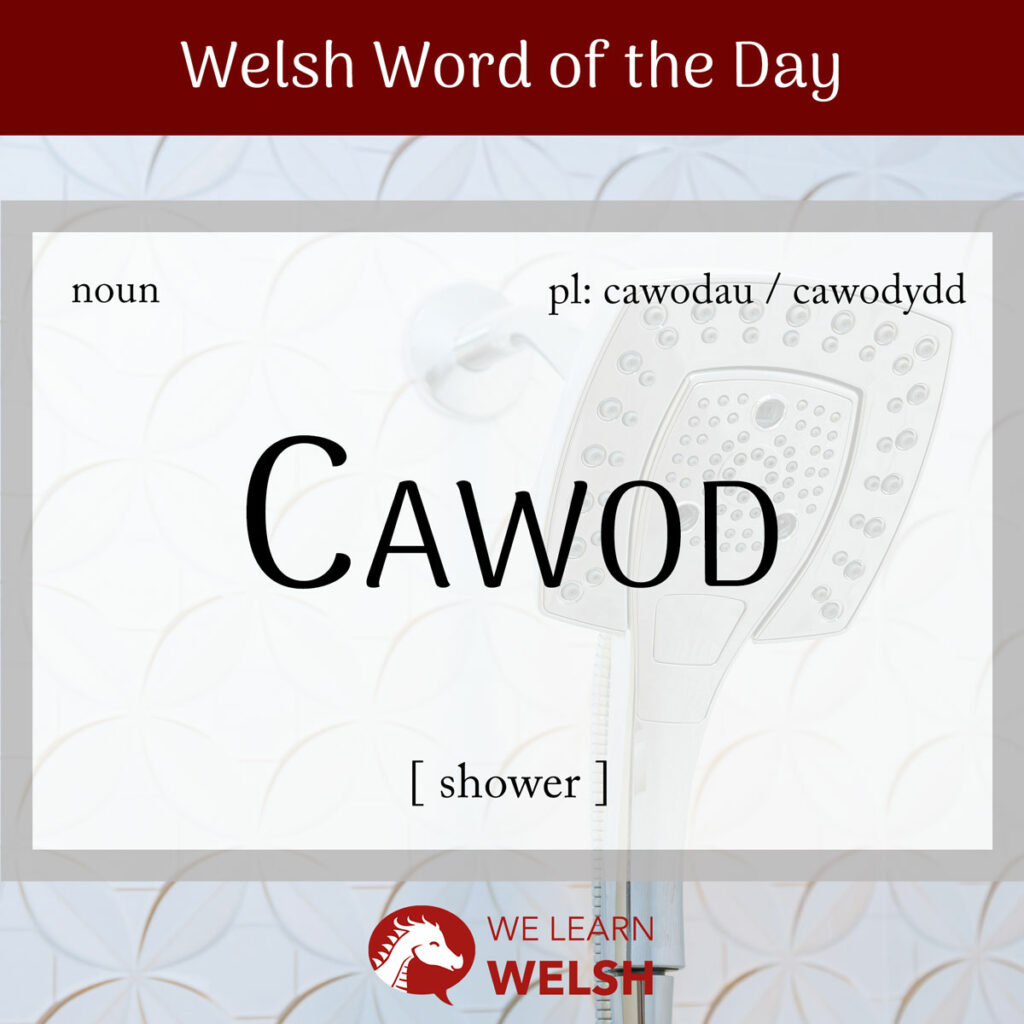I’ve always found it rather charming that in both Welsh and English, the word for a brief spell of rain is the same as the device most of us use to wash with in the bathroom. In Welsh, that word is cawod.
It can be pluralised as either cawodau or cawodydd. In my experience, the latter is more common, but your mileage may vary.
cawod
shower
cawodau
showers
It comes from the proto-Celtic *kowotos, which we can trace all the way back to the proto-Indo-European stem *kehw, used to build words with connotations of coldness, darkness, or rain. So the meteorological meaning is, as you might expect, the much older of the two.
*Kowotos, which became cawat in early Welsh, has also produced the variants cawad and cafod. Neither of these are as common as cawod but it would be possible to hear them in a remote Welsh-speaking corner of the country.
In the South, there are a few regional slang synonyms of cawod – in the context of weather – which are sgipen, mwgen, and ffwgen. They’re all feminine nouns, too, and they can be combined with cawod itself, producing phrases like sgipen o gawod (a light shower).
Since this is a feminine noun, it causes adjectives used to describe it to soft mutate, so a warm shower is cawod dwym, even though warm is twym. And it’s also going to take a soft mutation after the definite article y (the) – y gawod (the shower).
We’ve been talking about soft mutations, but here’s how cawod responds to all three kinds of Welsh mutations:
Soft mutation
gawod
Nasal mutation
nghawod
Aspirate mutation
chawod
The nasal mutation would come up in the phrase fy nghawod (my shower) or yng nghawod (in a shower), for example. The aspirate mutation would come in the phrase bath a chawod (a bath and a shower) or ei chawod (her shower).
Cawod is used to refer to all sorts of things beyond the basic meaning of dŵr disgyn (falling water). In parts of North Wales, it can describe a brech (rash) or a sudden attack of sickness. It’s also used across Wales to describe various clefydau (diseases) that planhigion (plants) can get – for example y gawod goch (the red shower) refers to a kind of red-looking fungus that infects planhigion, which in English is called rust.
Another, much cuter, gardening-related use of the phrase is in the term bili’r gawod, an occasional slang term for can dyfrio (watering can).
Oes angen ymbarél? Oes, fydd ‘na gawod yn fuan.
Will I need an umbrella? Yes, it’s soon to shower.
But although the Welsh word cawod has more meanings than the English, there are some uses of shower that we can’t automatically transplant onto cawod.
In English, we also use shower as a verb. Corresponding to the meanings of the noun, it can be translated as to rain lightly, to take a shower, or to shower something on someone / something.
In Welsh, cawod is not used as a verb. Some people might use cawodi to mean to take a shower, especially in the West and South of Wales. But these phrases are more common:
- gwneud cawod = to shower (of rain)
- disgyn yn cawodydd = to shower (of rain)
- bwrw glaw = to rain
- cael cawod = to take a shower
- pentyrru anrhegion (ar rywun) = to shower presents (on someone)
- dyrnu (rhywun) = to shower blows (on someone)
Some people also say mynd dan gawod instead of cael cawod.
There are a lot of good phrases to describe different types of cawodydd, too. I’m embarrassingly averse to glaw (rain), so when the sky goes llwyd (grey) and I realise that we’re at blaen y gawod (the start of a shower), I’m always hoping for a cawod sydyn / cawod fer (short shower). This is also casually called a gwlithen or rwshen in the Pembrokeshire area.
Whenever I’m at home in Wales I’m much more likely to be unlucky and have to suffer through a cawod drom (heavy shower). Stormau (storms) are thankfully less common, but that doesn’t stop me from complaining when the awyr (air / sky) is bwrw hen wragedd a ffyn (raining heavily, literally raining old women and sticks).
Dw i byth yn cael cawod yn y bore.
I never take a shower in the morning.
Luckily, when caught in the glaw, if you get too gwlyb (wet), you can always rush home to cael cawod within the comfort of your own stafell molchi (bathroom)!
Cawodydd for ymolchi (bathing / washing oneself) have a long history, tracing back to ancient Egypt and Mesopotamia. Even before that, many people used rhaeadrau (waterfalls) to shower under. Plymwaith (plumbing) was introduced by the ancient Greeks and borrowed by the Romans – Roman baddondai (bathhouses) still exist all over the UK.
Today, most people’s stafell molchi features a cawod or a baddon / bath (bath), a tŷ bach (toilet), and a sinc (sink). Within the cawod itself, you might find some of these things:
- sebon (soap)
- siampŵ (shampoo)
- sebon llyfnu / cyflyrydd gwallt (hair conditioner)
- brwsh gwallt (hair brush)
- raseli (razors)
- sebon eillio (shaving cream)
- spwnj (sponge)
- clwt molchi (flannel)
- lwffa (loofah)
Hopefully, you have a cawod that easily produces both dŵr poeth (hot water) and dŵr oer (cold water), otherwise your daily wash won’t be the most pleasant experience in the world!


